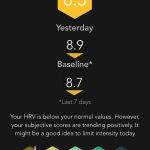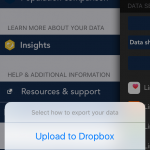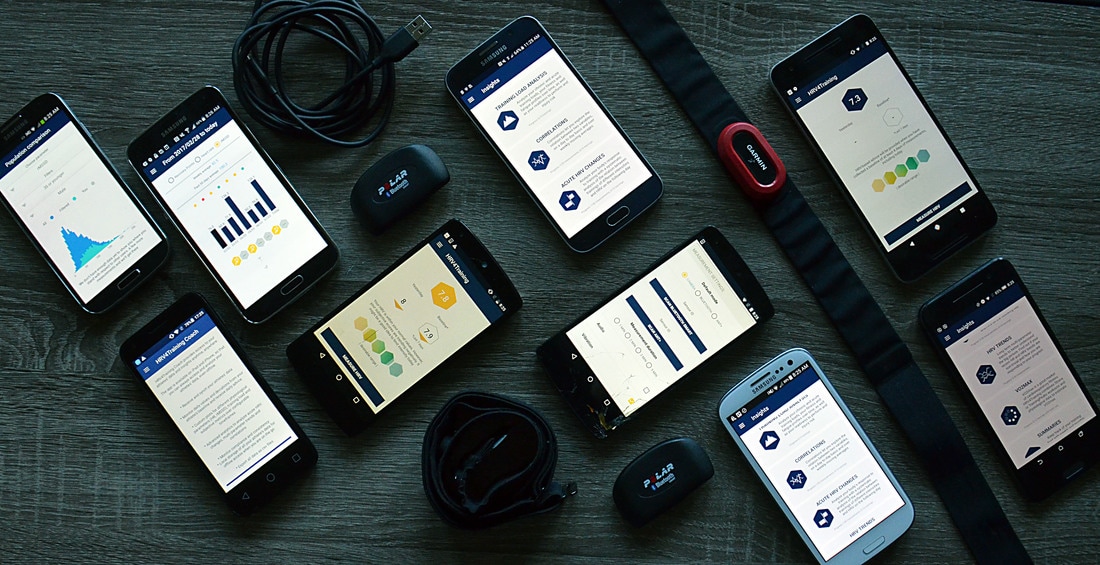
Written by “Massi” Milani
HRV4Training is an innovative Heart Rate Variability app with a strong marketing claim. It helps all athletes to optimize their performance by training smart, not more. Is this claim justified? what are the features and benefits? why should you pay for a tool that competes with thousands of other apps in the Heart Rate Variability arena? how to use properly the tool? With serious reporting dashboard competing with major websites like TrainingPeaks and Strava, do you need to be a rocket scientist to interpret all available data? This review aims to answer all these questions and much more.
HRV4Training helps tracking your Heart rate Variability and your recovery
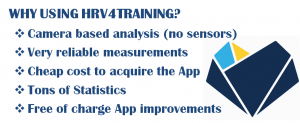 There are tons of features within HRV4Training. This document provides an overview of functions and insights that the tool offers, ranging from data acquisition, daily advice, insights on what to change in your training regime, along with data integration with the different systems in the market. We explain how annotations and workouts should be used as well as we describe integrations with other apps including SportTracks, Strava and TrainingPeaks. We have used the application for around 15 months on a daily basis, and supported its development, all new features like VO2Max estimate and Android release. We are ordinary athletes that focus on optimizing our marathon results and our view is biased toward performance. Thanks to our curiosity and time spent using the app, we have now a clear view on its key benefits.
There are tons of features within HRV4Training. This document provides an overview of functions and insights that the tool offers, ranging from data acquisition, daily advice, insights on what to change in your training regime, along with data integration with the different systems in the market. We explain how annotations and workouts should be used as well as we describe integrations with other apps including SportTracks, Strava and TrainingPeaks. We have used the application for around 15 months on a daily basis, and supported its development, all new features like VO2Max estimate and Android release. We are ordinary athletes that focus on optimizing our marathon results and our view is biased toward performance. Thanks to our curiosity and time spent using the app, we have now a clear view on its key benefits.
Heart rate Variability in a nutshell
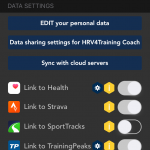 Before talking about HRV4Training, what the heck is Heart Rate Variability? In simple words, our heart does not beat at a constant frequency: even a great athlete with 35 beats per minutes will observe variations between heart beats. HRV is just a practical way to quantify such variations. Note that in the physiological literature there are several ways to measure beat to beat difference, we do not cover here the details since there are so many articles on the Internet. The real question for the ordinary athlete is however why do we measure Heart Rate Variability? medical studies indicates that our body autonomic nervous system is regulating many body functions, such as respiration, the heart beating and few others. With research it became clear that part of the nervous system (the parasympathetic branch) was responsible to promote rest and recovery. Heart Rate Variability is just a way to measure our ability to recover after intense training. In other words, analyzing HRV data helps to understand how much time our body has to recover after an intense workout. The higher the variability, the better our 35 bpm athlete has recovered. But then how do we measure Heart Rate Variability?
Before talking about HRV4Training, what the heck is Heart Rate Variability? In simple words, our heart does not beat at a constant frequency: even a great athlete with 35 beats per minutes will observe variations between heart beats. HRV is just a practical way to quantify such variations. Note that in the physiological literature there are several ways to measure beat to beat difference, we do not cover here the details since there are so many articles on the Internet. The real question for the ordinary athlete is however why do we measure Heart Rate Variability? medical studies indicates that our body autonomic nervous system is regulating many body functions, such as respiration, the heart beating and few others. With research it became clear that part of the nervous system (the parasympathetic branch) was responsible to promote rest and recovery. Heart Rate Variability is just a way to measure our ability to recover after intense training. In other words, analyzing HRV data helps to understand how much time our body has to recover after an intense workout. The higher the variability, the better our 35 bpm athlete has recovered. But then how do we measure Heart Rate Variability?
Without any further ado, let’s unbox HRV4Training.
Unboxing and HRV4Training Setup
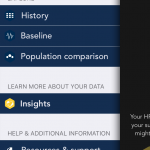 There are multiple ways to measure HRV but the cost effective one is through our mobile phones. Garmin has also some key functionalities within their watches, however, those are so basic that do not satisfy the average analytical athlete. HRV4Training is the
There are multiple ways to measure HRV but the cost effective one is through our mobile phones. Garmin has also some key functionalities within their watches, however, those are so basic that do not satisfy the average analytical athlete. HRV4Training is the
answer for somebody who cares about training and recovery since it allows to gather a plethora of data points and analyse them through simple and easy reporting. But how do we start?
No need for unboxing anything, to use the tool you just need a phone, with iOS and since March 2017 with Android. In principle you do not need any Heart Rate Strap, because HRV4Training can potentially collect you Heart Rate Variability with the mobile phone camera. On iPhone, the camera based acquisition was recently clinically validated by the High Performance Sport New Zealand study. Setting up your account is straightforward, but the author has allowed tremendous flexibility to comply with different requirements.
Measure HRV
As a user, you can make different choices before using the tool. HRV4Training requires to answer four questions: 1) how would you like to measure your Heart Rate Variability? 2) for how long would you like to measure it, and what kind of feedback would you like to have during the measurement? 3) what parameters would you like to see reported? 4) which apps should HRV4Training share data with? All questions are very important for the tool, let’s go over them in more detail.
The first two questions are the simplest to answer.
How to measure your Heart Rate Variability? HRV4Training provides three methods to collect data on Heart Rate Variability. The first one uses the phone camera, while the other two require connection with a valid Heart Rate strap:
Camera based. This is definitely the best option, and works perfectly with all iPhones but also with the most recent Android phones. Putting your finger on the camera does the magic: HV4Training measures your Heart Rate Variability without effort. In our tests it is as much accurate as the Strap, especially on IPhone. For Android it depends on your phone. Several testers demonstrated that it works well on different models, but the differences among manufacturers, models and software makes it impossible to verify correctness in practice on all phones. Using this method requires some experimentation, to get familiar with camera based measurement. It is not very hard, but our advice is to practice couple of times. A validation of the Camera Heart Rate Variability in comparison with a normal HR strap has been made analytically already years ago, we have read the latest camera publication and we believe there are convincing arguments to use the camera instead of Heart Rate Strap. We ran a few tests with Android and IPhone and confirmed similar outcomes, during simultaneous measurements.
Bluetooth Smart. The second option and our preferred choice is to use an Heart Rate strap. We like the idea since it allows for more relaxation during the measurement. In our view, it is just a matter of taste: using the camera you need to pay attention on how to put your index finger on the camera, while for the HR strap it is super easy. If you are running on a Treadmill, it is very likely that you have already at home a Polar H7 strap, otherwise get one on Amazon.com. Our experience shows that Bluetooth connectivity with the phone is better with the IPhone, but obviously it is really dependent on your hardware. Polar H7 and Wahoo Tickr work perfectly in all occasions.
ANT+, through internal radio or third party adapter. If you are lucky enough that your Android phone includes also the Ant plus technology, you could utilize also your Garmin strap. Before getting excited, you first need to install a few Ant programs (ANT Radio Service, ANT+ Plugins Service, ANT USB Service), not a very complex task but time consuming, especially if connection is not plug and play. Finally please note that this option is not available on IPhone.
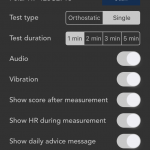 For how long do you want to measure HRV? The second choice is also straightforward but important. Each athlete has to decide how long would like to measure his or her Heart beats to determine its Variability. The golden standard of HRV measurement is 5 minutes, which is how all studies have been carried out historically. However recently 1-minute measurements are considered the most effective way to assess your variability and do not indicate any major difference versus longer intervals. Do you really have four more minutes in the morning to test your HRV? Up to you, anyway you can also choose 2 or 3 minute measurements.
For how long do you want to measure HRV? The second choice is also straightforward but important. Each athlete has to decide how long would like to measure his or her Heart beats to determine its Variability. The golden standard of HRV measurement is 5 minutes, which is how all studies have been carried out historically. However recently 1-minute measurements are considered the most effective way to assess your variability and do not indicate any major difference versus longer intervals. Do you really have four more minutes in the morning to test your HRV? Up to you, anyway you can also choose 2 or 3 minute measurements.
Making sense of our data with Tags
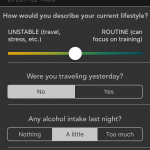 Once you have established your measurement choice, both in term of sensor and timing, you have to configure Tags, which are parameters that HRV4Training reports and updates after each measurement. In other words, the app combines HRV data, with information that can be derived by your experience.You can annotate not only training days and intensities but also a series of other events that can affect physiological stress, performance, and training. For example sleep quality, mental tiredness, muscle fatigue. This is an important step in the configuration, therefore try to spend time in assessing what you would like to measure. If you do not select some parameters, you cannot assess six months down the road whether they will have impact on your rest/recovery cycle. Did you drink heavily last night? Do you like wine tasting? If you want to understand the impact on HRV, you could configure a tag linked to this event, and the app will analyze the impact of drinking on your HRV. Are you a frequent traveler? Don’t worry, since it is known that traveling has an impact on your body, you can easily track it. To summarize, tags make sense of your data. At the same time, not all parameters are useful, so it might be a waste of time to record each morning at what time you wake up, if your sleeping regime is constant. We will cover each parameter below.
Once you have established your measurement choice, both in term of sensor and timing, you have to configure Tags, which are parameters that HRV4Training reports and updates after each measurement. In other words, the app combines HRV data, with information that can be derived by your experience.You can annotate not only training days and intensities but also a series of other events that can affect physiological stress, performance, and training. For example sleep quality, mental tiredness, muscle fatigue. This is an important step in the configuration, therefore try to spend time in assessing what you would like to measure. If you do not select some parameters, you cannot assess six months down the road whether they will have impact on your rest/recovery cycle. Did you drink heavily last night? Do you like wine tasting? If you want to understand the impact on HRV, you could configure a tag linked to this event, and the app will analyze the impact of drinking on your HRV. Are you a frequent traveler? Don’t worry, since it is known that traveling has an impact on your body, you can easily track it. To summarize, tags make sense of your data. At the same time, not all parameters are useful, so it might be a waste of time to record each morning at what time you wake up, if your sleeping regime is constant. We will cover each parameter below.
Daily HRV measuring and advice
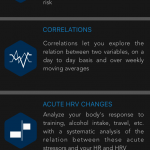 After a complete configuration, you are ready to go. You just need 2 minutes to collect all data, one minute for the HRV measurement, the second to update all key tags that you have defined in the previous steps. When should you measure? Obviously there might be several choices, including just before training. However, the HRV literature suggests to be constant, therefore the best way to do it is each morning as soon as you wake up. In our view, the morning routine is crucial: measuring with the same tool, in the same position, at the same time. How and when you measure the data has an impact on HRV results: in our experience keeping the same monitoring routine allows you to capture overall physiological stress from previous days due to life stressors and workouts. This will help to provide more meaningful advice and insights.
After a complete configuration, you are ready to go. You just need 2 minutes to collect all data, one minute for the HRV measurement, the second to update all key tags that you have defined in the previous steps. When should you measure? Obviously there might be several choices, including just before training. However, the HRV literature suggests to be constant, therefore the best way to do it is each morning as soon as you wake up. In our view, the morning routine is crucial: measuring with the same tool, in the same position, at the same time. How and when you measure the data has an impact on HRV results: in our experience keeping the same monitoring routine allows you to capture overall physiological stress from previous days due to life stressors and workouts. This will help to provide more meaningful advice and insights.
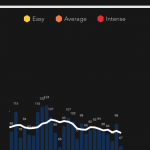 Daily advice. The beauty of HRV4Training is the ability to measure changes in HRV on daily basis. The app applies algorithms that evaluate whether to train easy or hard on a given day. Using the past 30 days of data, HRV4Training determines our baseline: what our normal HRV values are, what variations are just normal day to day changes and which ones are more meaningful. This would then assess whether our 35 beats per minute athlete is in good shape or in Stress/Recovery mode. In other words, the daily advice can be used to understand under how much stress your body is, and suggest whether it makes sense to adjust our training program accordingly.
Daily advice. The beauty of HRV4Training is the ability to measure changes in HRV on daily basis. The app applies algorithms that evaluate whether to train easy or hard on a given day. Using the past 30 days of data, HRV4Training determines our baseline: what our normal HRV values are, what variations are just normal day to day changes and which ones are more meaningful. This would then assess whether our 35 beats per minute athlete is in good shape or in Stress/Recovery mode. In other words, the daily advice can be used to understand under how much stress your body is, and suggest whether it makes sense to adjust our training program accordingly.
Complicated? Actually, I assume that I am not the only one that at 6 am is still dreaming, so I will not be able to solve differential equations. The app has a traffic light: you train as expected if you got green, you train easy if you get yellow, and you rest if you get red. HRV4Training calculates several metrics of HRV, converted in simple points, and compared with the baseline and normal values. For the curious athlete, the daily advice is based on complex rules and takes into account the last 7 days moving average, the normal values, and subjective scores and recent trends. The algorithm has improved over the recent months, and we believe this is the key reason to use HRV4Training as Heart Rate Variability app.
Reporting history and baseline
According to our benchmark, reporting is where HRV4training has an edge over the other HRV applications. There are three major reporting tools, the history page, where you can see all HRV metrics of previous weeks, the baseline page, where the tool calculates trends, and the population page, which allows comparison versus other athletes using the tool.
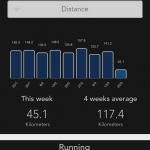 History page. This page gives you all possible combinations of HRV metrics, you should focus on rMSSD and HR at rest as key ones. The history page indicates graphically also the impact of some of your tags (for instance, you can see travel, alcohol intake, menstruation and injuries) on the athlete’s physiological stress level. Overall, a good reporting tool to assess how your week is developing.
History page. This page gives you all possible combinations of HRV metrics, you should focus on rMSSD and HR at rest as key ones. The history page indicates graphically also the impact of some of your tags (for instance, you can see travel, alcohol intake, menstruation and injuries) on the athlete’s physiological stress level. Overall, a good reporting tool to assess how your week is developing.
Baseline page. The Baseline page has longer horizon, giving a mid term view on HR variability. The system draws a blue line which is a 7-days HRV moving average, capturing a long term trend of an athlete’s HRV. We should not forget that daily variation are normal, but mid term trends clearly indicate our ability to recover and to manage stress in our long term training plan.
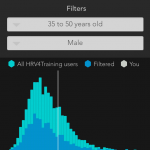 Population comparisons: in this page you can see how you compare with respect to other HRV4Training users. You’ll be able to pick different physiological parameters (heart rate, rMSSD, Recovery Points) as well as stratify by age and gender. On the HRV4training blog, there is a great document explaining the HR and HRV population values.
Population comparisons: in this page you can see how you compare with respect to other HRV4Training users. You’ll be able to pick different physiological parameters (heart rate, rMSSD, Recovery Points) as well as stratify by age and gender. On the HRV4training blog, there is a great document explaining the HR and HRV population values.
Insights: learn more about your data
HRV4Training is offering long term perspectives based on combined training and physiological data. In the tool there are several analytics to evaluate acute HRV changes and long term trends. The insights page gives key information not on how to train a daily basis, but to assess the big picture: is your training plan helping to improve your performance or has little impact? We believe that some of these reports are unique to the tool, and as analytical athletes we value tremendously the insights reporting:
Weekly and monthly summaries. This is the simplest available report, providing weekly and monthly trends for several metrics (for example, RPE, TSS, Suffer Score, training distance). Weekly and monthly summaries are a great tool that gives training load breakdowns and helps keeping track of overall progress.
Acute HRV changes. Are we physiologically rested after rest days and easy trainings? How does travel affect our physiology? What drop in HRV can we expect after an intense training? As explained in the Tags paragraph, having the right measurement allows to assess systematically day to day changes in HRV. For instance, you can evaluate impact not only on training, but also on alcohol intake, travel, menstruation and sick days using the Acute HRV Changes analysis.
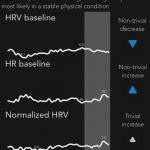 HRV trends. Trends help the analytical athlete to assess whether the training plan is consistent with our expectations on performance. HRV trends in fact convert raw data into the big picture. The app can automatically determine if your recent HR or HRV trend is changing in a trivial way, or if the change is something to take more seriously. The app can always analyze the relation between changes in training load and physiological data (HRV baseline, HRV, coefficient of variation, training load) that might have an impact on our physical condition.
HRV trends. Trends help the analytical athlete to assess whether the training plan is consistent with our expectations on performance. HRV trends in fact convert raw data into the big picture. The app can automatically determine if your recent HR or HRV trend is changing in a trivial way, or if the change is something to take more seriously. The app can always analyze the relation between changes in training load and physiological data (HRV baseline, HRV, coefficient of variation, training load) that might have an impact on our physical condition.
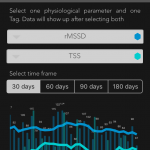 Correlations. Another interesting piece of HRV4training reporting is correlations. Correlations will help to assess what factors are related to physiological changes and let you explore your tags. Are you sleeping too little? are you training too heavily? With this exploratory analysis you can find some interesting insights.
Correlations. Another interesting piece of HRV4training reporting is correlations. Correlations will help to assess what factors are related to physiological changes and let you explore your tags. Are you sleeping too little? are you training too heavily? With this exploratory analysis you can find some interesting insights.
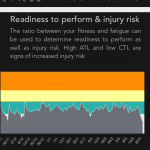 Training load analysis. The author of HRV4training has developed a full reporting on load analysis. We normally use TSS for our reporting, but you can use other metrics, including Suffer Score, HR or Distance, and the system will analyze fitness and fatigue. Why is it important? Based on the outcome, you can determine readiness to perform, as well as injury risk.
Training load analysis. The author of HRV4training has developed a full reporting on load analysis. We normally use TSS for our reporting, but you can use other metrics, including Suffer Score, HR or Distance, and the system will analyze fitness and fatigue. Why is it important? Based on the outcome, you can determine readiness to perform, as well as injury risk.
Training polarization analysis: this analysis allows you to get an overview of how hard you are training and potentially polarize more your training, as a more polarized approach, typically involving training about 80% of the time at very low intensities, has been shown to improve performance for both recreational and elite athletes.
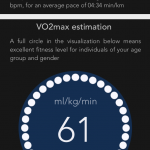 VO2max estimation: HRV4Training can estimate cardiorespiratory fitness level (VO2max). VO2max is estimated now by multiple devices, including Garmin and Suunto watches. In order to use this functions, you have to link HRV4Training to Strava or TrainingPeaks, and use an HR strap when you train.
VO2max estimation: HRV4Training can estimate cardiorespiratory fitness level (VO2max). VO2max is estimated now by multiple devices, including Garmin and Suunto watches. In order to use this functions, you have to link HRV4Training to Strava or TrainingPeaks, and use an HR strap when you train.
Data integrations and export
Life is easy. HRV4Training was initially a standalone application and required lot of manual input. Not anymore. If you activate the integration with Strava or TrainingPeaks, many training metrics are automatically compiled, saving valuable time in the morning.
Integration with other systems. You can export data from other systems as well. In particular, HRV data can be exported to SportTracks or TrainingPeaks, and you can see trends in their websites.
Data Export. Finally, you can see HRV4training as a gigantic database which measures how your body react to stress and recovery. Compared to large websites or apps, the author fully understands data and knows that user data are owned by their users. We found very useful that HRV4Training has the option to extract data in CVS format: you can download it via Dropbox and/or email. We believe that all standard reporting are available from the app, but if you want to do something customized, this feature is very helpful.
HRV4Training on Android
Starting from March 2017, HRV4Training is also available on Android phones. We were part of the beta testers since January and supported its development. Obviously Android is a different operating system compared to iOS, but we found that the user experience is pretty similar compared to the one that we got on the iPhone.
We saw minor variations:
– all key functions are there, and there is also a possibility to use Garmin Heart strap, which is not available on iPhone. This assumes of course that your mobile phone has Ant+ connectivity
– camera based measurement works well, but it depends on your phone. New ones work, old ones maybe. We found that the Android measurement makes the camera hotter, but again Android is not a standardized platform so your experience might be different
– Bluetooth heart rate strap is recognized faster by the iPhone than by Android. This is probably a personal opinion influenced by the cellular phone I have, however it is clear that both phones are able to connect with Polar H7, and few other straps.
Finally, you have to consider that HRV4Training for Android is build on the same logical platform as on iOS, but that at the same time it is also a new tool. Lots of testing has been carried out, but be patient in case things don’t work from the beginning. The author is very responsive in correcting potential bugs, and we believe that if you provide the right feedback, everything will be solved fast.
Conclusions and additional HRV readings
Resources and Support. You can find in the app an additional menu, which in fact provides valuable resources and tips on how to use the tool. In particular, in HRV4Training you can find a link on how to use the camera. You can also use a practice test, which allows you to test the camera in real conditions. Moreover there is a link to the blog, which is an interesting set of resources and provides more details on the different functionalities and data analytics. Finally, you can also find the Facebook link as well as the Strava HRV4Training club, in case you would like to follow peers in their training. HRV4Training Coach. In case you are a coach, you can also find a link that explains how to use the sibling tool called HRV4Training Coach. This is basically a tool that allows to see data from your team.
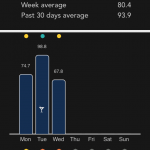
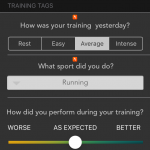
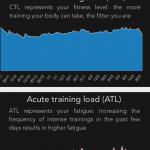 HRV4Training is a fantastic tool to measure not only your current Heart Rate Variability, but also our long term fitness. Despite the availability of several competitors in this arena, our analytical athlete would appreciate the strong reports and insights coming from this tool. For a simple athlete like us, we have loved the simplicity of the baseline page, as well as advice on how to train. Despite all super detailed dashboards, we think that the algorithms behind HRV4Training deliver great advice.
HRV4Training is a fantastic tool to measure not only your current Heart Rate Variability, but also our long term fitness. Despite the availability of several competitors in this arena, our analytical athlete would appreciate the strong reports and insights coming from this tool. For a simple athlete like us, we have loved the simplicity of the baseline page, as well as advice on how to train. Despite all super detailed dashboards, we think that the algorithms behind HRV4Training deliver great advice.
Go get a Polar H7 (or use the camera if you prefer) and start downloading the app.
If you are disciplined enough to measure your Heart Rate Variability on a daily basis, HRV4training you can provide great insights on your training plans and rest and recovery cycle.
Note that with the launch of HRV4training for Android, there is a 20% discount for the first three days.

